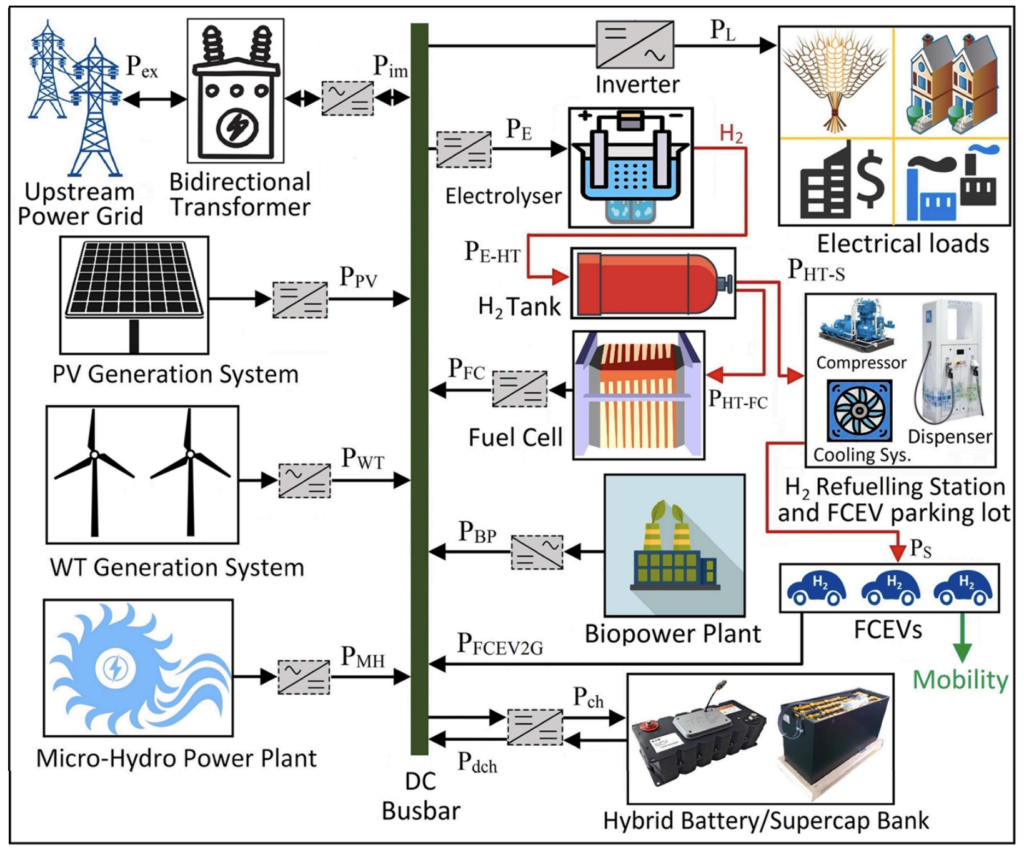The Role of Green Hydrogen in Driving the Deployment of Integrated Sustainable Energy Systems
Written by Soheil Mohseni and Alan Brent
Green hydrogen is increasingly recognized as an important enabler of the energy transition in integrated energy system plans and, accordingly, a key component in achieving net-zero emissions economies. To this end, optimizing the integration of green hydrogen technologies into smart integrated renewable and sustainable energy systems requires characterizing the associated interactions with alternative low-carbon technologies with a system-of-systems perspective. In this context, this article first provides a brief overview of the promising green hydrogen configurations for community energy solutions before bringing to light supporting techniques and interventions, such as energy storage hybridization and energy arbitrage.
Promising Green Hydrogen Configurations for Community Energy
The cost-effectiveness, reliability, and efficiency of transitioning to a green hydrogen economy (with hydrogen treated as an energy carrier/vector) where polymer electrolyte membrane (PEM) fuel cells are used in stationary backup distributed generation and automotive (particularly, light-duty-vehicle, heavy transport, and agricultural machinery sectors) applications are increasingly shown to be of significant importance for facilitating community energy systems1, 2. That is, conceptual hydrogen-based community energy systems demonstrate the promise of a fuel-cell-based green hydrogen economy for stationary applications, especially vis-à-vis the transportation sector.
On the other hand, hydrogen production using a united anaerobic reactor-reformer system that converts the organic fraction of municipal solid waste, as well as the agricultural residues, into hydrogen can provide a practical solution to manage the agricultural and municipal solid waste of remote, island, rural, peripheral, and semi-urban communities, in a cost-optimal and self-sufficient way that promotes energy democracy and independence – which directly contributes to the sustainable waste management, transport, and agriculture efforts in conjunction with sustainable energy provision.
On a demand-side level, vehicle-to-grid (V2G) resources associated with hydrogen fuel cell vehicles can be potentially unlocked using effective demand response aggregator-mediated V2G-addressable energy management frameworks to provide a “level playing field” for their flexibility services. In this way, the integration of fuel cell electric vehicle-to-grid (FCEV2G) services3 can particularly influence the system-level dispatch and delivery of sectoral demand response resources and, in turn, the sizing of smart integrated renewable and sustainable energy systems.
Figure 1 illustrates a conceptual hydrogen-supported sustainable energy system considering the electrification of transport using hydrogen fuel cell vehicles.

Figure 1: Illustration of a notional hydrogen-based 100%-renewable community energy system.
Importance of Hybrid Energy Storage Systems
The optimal hybridization of different energy storage technologies across a broad spectrum of disparate timescales, in compliance with the timescale relevant to the technical capabilities of each technology, has also been recognized to be particularly useful in minimizing the risk of renewable energy system sub-optimality4. More specifically, multi-energy-storage-technology community energy systems benefit from reduced overall costs, minimum excess curtailment, and improved system efficiency. In this setting, a technically viable and financially sustainable hybridization choice for multi-energy, integrated community renewable energy systems is widely recognized to be the combination of hydrogen with battery storage and super-capacitor storage respectively for long-term, medium- to short-term, and ultra-short-term energy storage needs (see Figure 1)5.
Economics of Energy Arbitrage
Valuing the operational benefits of arbitrage strategies – by charging the storage devices using low-cost energy during the system- and utility-grid-wide off-peak periods and discharging them during higher-priced coincident peak periods has also gained significant interest recently6.
However, there is an important consensus in the literature that at the existing costs and efficiencies of hydrogen storage systems, long-duration (discharge duration >10 hours and <100 hours) and seasonal arbitrage (discharge duration >100 hours) alone is not a viable market niche for hydrogen storage. Rather, it can be regarded as a value-enhancing service if accompanied by an economic dispatch strategy tailored to managing the hydrogen storage capacity in a forward-looking manner – by simultaneously contributing to procuring seasonal onsite energy reserves – which would otherwise remain underutilized within the community energy context. In other words, the community-scale hydrogen energy storage systems are able (in expectation) to reach viable profitability levels when used for energy arbitrage reasons in conjunction with the onsite backup provision and not yet-commoditized network services. Accordingly, seasonal load leveling using hydrogen storage infrastructure is generally found to be a better approach than seasonal peak imports and overbuilding of renewable generation – which would rarely be used internally during the off-peak season7.
In conclusion, hydrogen and fuel cell technologies can facilitate the community-level integration of renewables by providing an effective platform for seasonal storage (to effectively serve low-temperature heating loads) and transportation sector electrification interventions, with the latter also benefiting from the increased ability to manage grid peaks and fluctuations through specifically developed vehicle-to grid (FCEV2G) opportunities. Accordingly, a hydrogen-based energy economy can significantly contribute to the sustainable transportation goals, and particularly add to the collective efforts towards community-centered sustainable socio-economic development.
References
- International Energy Agency (IEA), 2019. The Future of Hydrogen. [Online]. Available: https://www.iea.org/reports/the-future-of-hydrogen (accessed: 21-Dec-2022).
- E. Miller et al., “U.S. Department of Energy Hydrogen and Fuel Cells Program: Progress, Challenges and Future Directions,” Cambridge University Press, vol. 1, pp. 2839¬–2855, 2016.
- C. B. Robledo, V. Oldenbroek, F. Abbruzzese, and A J. M.van Wijk, “Integrating a hydrogen fuel cell electric vehicle with vehicle-to-grid technology, photovoltaic power and a residential building,” Applied Energy, vol. 215, pp. 615-629, 2018.
- T. S. Babu et al., “A Comprehensive Review of Hybrid Energy Storage Systems: Converter Topologies, Control Strategies and Future Prospects,” IEEE Access, vol. 8, pp. 148702–148721, 2020.
- S. Mohseni, A. C. Brent, S. Kelly, W. N. Browne, and D. Burmester, “Strategic design optimisation of multi-energy-storage-technology micro-grids considering a two-stage game-theoretic market for demand response aggregation,” Applied Energy, vol. 287, p. 116563, 2021.
- S. Mohseni and A. C. Brent, “A Metaheuristic-Based Micro-Grid Sizing Model with Integrated Arbitrage-Aware Multi-Day Battery Dispatching,” Sustainability, vol. 14, p. 12941, 2022.
- D. Steward, G. Saur, M. Penev, and T. Ramsden. Lifecycle Cost Analysis of Hydrogen Versus Other Technologies for Electrical Energy Storage. National Renewable Energy Lab. (NREL), Golden, CO (United States), 2009.
This article was edited by Vijay Sood.
To view all articles in this issue, please go to February 2023 eBulletin. For a downloadable copy, please visit the IEEE Smart Grid Resource Center.

Soheil Mohseni is a Postdoctoral Research Fellow in Sustainable Energy Systems at Te Wāhanga Ahunui Pūkaha–Wellington Faculty of Engineering, Te Herenga Waka–Victoria University of Wellington in Aotearoa–New Zealand. His research revolves around developing a demand response-centered method to optimally size on-/off-grid micro-grids using AI-based meta-heuristic optimization algorithms considering model-inherent parametric uncertainties. In his project, he engages directly with public- and private-sector energy stakeholders, as well as remote and rural communities in Aotearoa–New Zealand, to understand how energy planning optimization can drive the deployment of stand-alone and grid-connected renewable energy systems.

Alan Brent is a professor and the inaugural holder of the Chair in Sustainable Energy Studies at Te Wāhanga Ahunui Pūkaha–Wellington Faculty of Engineering, Te Herenga Waka–Victoria University of Wellington in Aotearoa–New Zealand. He holds Bachelor’s degrees in Engineering (Chemical) and Philosophy (Sustainable Development); Master’s degrees in Science (Environmental Engineering), Engineering (Technology Management), and Philosophy (Sustainable Development); and a Ph.D. in Engineering Management. He is a chartered member of Engineering New Zealand, a member of the IEEE Power and Energy Society, and an executive committee member of The Sustainability Society.
To have the Bulletin delivered monthly to your inbox, join the IEEE Smart Grid Community.
Past Issues
To view archived articles, and issues, which deliver rich insight into the forces shaping the future of the smart grid. Older Bulletins (formerly eNewsletter) can be found here. To download full issues, visit the publications section of the IEEE Smart Grid Resource Center.




